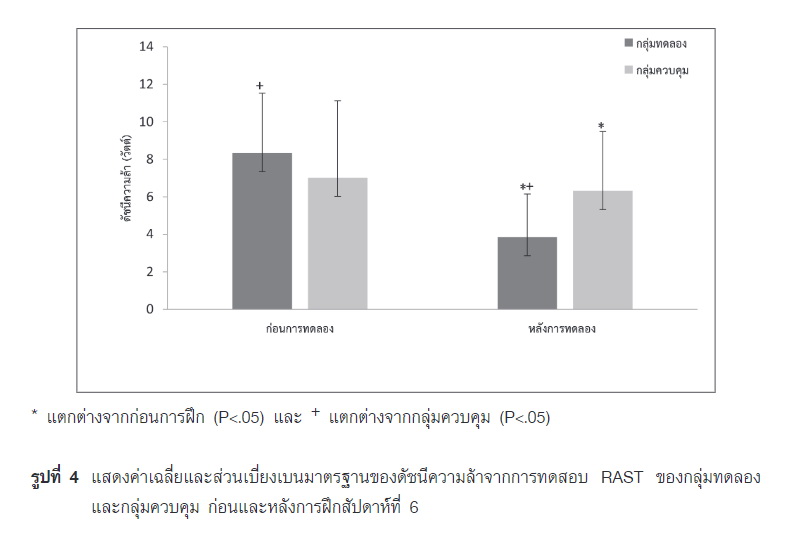EFFECTS OF SPEED ENDURANCE TRAINING ON AEROBIC AND ANAEROBIC CAPACITY IN COLLIGIATE MALE FOOTBALL PLAYERS
Main Article Content
Abstract
Purpose This study aimed to investigate the effect of speed endurance training on aerobic and anaerobic capacity in male collegiate football players
Method Thirty-two male football players, aged between 18-22 years, from Nakhon Ratchasima Rajabhat University were recruited and voluntarily participated in this study. The participants, matched by their maximal oxygen uptake (VO2max), were randomly assigned into 2 groups (n=16/each group). In the experimental group, the participants underwent speed endurance training program, consisted of 6 sets of a 20 meters run forward and backward with a maximum speed for 30 seconds interspersed by 180 seconds of recovery, twice a week for 6 weeks in addition to their normal training, while the control group performed a normal training program only. Before and after 6-week of training, the Yo-YoIR1 test, repeated sprint ability (RAST) test, and blood lactate concentration were determined. Data were analyzed using dependent and independent samples t-test to determine the statistical significance level at p- value <.05.
Results: Before the experiment, the mean age, height, body weight and VO2max did not differ (p>.05) between two groups. After 6 weeks of training, the experimental group showed significant higher (p<.05) in the distanced covered by Yo-YoIR1 test and tolerance to fatigue, as measured by fatigue index, during RAST test compared to prior training and control group. Blood lactate concentration at immediately post-exercise was also lower (p<.05) in the experiment group than in the control group after 6-week of training.
Conclusion: An additional of 6-week of speed endurance training to normal training, twice a week, is more effective for improving both aerobic and anaerobic capacity in male college football players when compared to normal training only. therefore, speed endurance training, can be used as a supplemented exercise for enhancing physical performance in collegiate football players.
Article Details
References
Bangsbo, J., Gunnarsson, T. P., Wendell, J., Nybo, L., & Thomassen, M. (2009). Reduced volume and increased training intensity elevate muscle Na+-K+ pump α2-subunit expression as well as shortand long-term work capacity in humans. Journal of Applied Physiology, 107(6), 1771-1780.
Bradley, P. S., Mohr, M., Bendiksen, M., Randers, M. B., Flindt, M., Barnes, C., ... & Bangsbo, J. (2011). Sub-maximal and maximal Yo-Yo intermittent endurance test level 2: heart rate response, reproducibility and application to elite soccer. European Journal of Applied Physiology, 111(6), 969-978.
Edson I. Kaminagakura, Alessandro M. Zagatto, Paulo E. Redkva, Elton B. Gomes, Joao P. Loures and Carlos A. Kalva-Filho. (2012). Can the running-based anaerobic sprint test be used to predict anaerobic capacity? Journal of Exercise Physiology Online, 15(2): 90-99.
Hostrup, M.& Bangsbo,J. (2017) Limitations in intense exercise performance of athletes – effect of speed endurance training on ion handling and fatigue development. Journal of Physiologhy (London). 595(9): 2897-2913.
Iaia, F. M., Thomassen, M., Kolding, H., Gunnarsson, T., Wendell, J., Rostgaard, T., & Bangsbo, J. (2008). Reduced volume but increased training intensity elevates muscle Na+ -K+ pump α1-subunit and NHE1 expression as well as short-term work capacity in humans. American Journal of Physiology-Regulatory, Integrative and Comparative Physiology, 294(3), R966-R974.
Iaia, F, & Bangsbo, J. (2010). Speed endurance training is a powerful stimulus for physiological adaptations and performance improvements of athletes. Scandinavian Journal of Medicine & Science in Sports, 20(s2), 11-23.
Mahdi Bayati, Babak Farzad, Reza Gharakhanlou., & Hamid Agha-Alinejad. (2011). A Practical Model of Low-Volume High-Intensity Interval Training Induces Performance and Metabolic Adaptations That Resemble ‘All-Out’ Sprint Interval Training. Journal of Sports Science and Medicine. 10(3): 571-576.
Mohr, M., Krustrup, P., Nielsen, J. J., Nybo, L., Rasmussen, M. K., Juel, C., & Bangsbo, J. (2007). Effect of two different intense training regimens on skeletal muscle ion transport proteins and fatigue development. American Journal of Physiology-Regulatory, Integrative and Comparative Physiology, 292(4), R1594-R1602.
Stølen, T., Chamari, K., Castagna, C., & Wisløff, U. (2005). Physiology of soccer. Sports medicine, 35(6), 501-536.
Salaj, S. and G. Markovic (2011). Specificity of jumping, sprinting, and quick change-ofdirection motor abilities. The Journal of Strength & Conditioning Research 25(5): 1249-1255.


